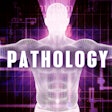
Does digital pathology offer benefits over the light microscope in viewing whole-slide images? A new study found that a digital microscope providing simultaneous views of multiple sections of tissues was easier, more efficient, and reduced the time to diagnosis for the pathologists who used it. The findings were published on January 17 in the Journal of Clinical Pathology.
Specifically, the digital microscope reduced the time per case for pathologists to make a diagnosis by one minute and 21 seconds per case, amounting to a relative reduction of 26% compared to the light microscope, according to the study, led by Dr. Emily Clarke of the pathology and data analytics division at the University of Leeds in the U.K.
"The digital system minimises the effort to manually switch between separate slides, instead offering the user a one-touch method of reviewing the case," the authors wrote. (Am J Clin Pathol, January 17, 2022)
How pathologists spend their time
The pathology department at the University of Leeds routinely digitally scans 100% of cases that come through the department. They have found that digital pathology systems offer numerous advantages, such as improved workflow, increased efficiency, and reduced impact of human error, the authors noted.
However, the authors also pointed out that problems such as high costs and poorly integrated software have led to slow uptake of the systems, especially in smaller institutions.
The same team of researchers was responsible for a previous design of whole-slide imaging (WSI) software for fast viewing called the Leeds Virtual Microscope. Building on that work, they designed the software described in the current paper that allows for side-by side viewing of multiple sections of tissue for comparison, which is not possible with light microscopy.
The authors noted that pathologists spend slightly more than 60% of their time actually viewing images under the microscope, with the remainder of their time spent on manual chores, such as removing slides from slide trays and adjusting slides on the microscope stage.
"We anticipate that viewing multiple slides side by side will be of significant time benefit to pathologists," the authors wrote. "It will be particularly beneficial in large resection cases, or cases where there are multiple immunohistochemical-stained slides (approximately 13% of cases within our institution)."
Time to diagnosis
In this study, the researchers investigated the time taken to reach diagnosis with a digital pathology system to see if it does indeed offer the promised time savings.
A custom viewer was designed that allowed side-by-side viewing of liver biopsy cases, including an immunohistochemical panel. The review was done by 16 histopathologists who evaluated three different liver biopsy cases, including an immunohistochemical panel using either the digital microscope or the light microscope.
 The screen layout of the digital microscope. The whole-slide images are viewed on a large 6-megapixel, medical-grade display, and the thumbnails (right) are viewed on a smaller portrait, 2-megapixel display to navigate between slides. The leftmost panel shows a high-resolution (3-megapixel) view of the hematoxylin and eosin (H&E)-stained slide; the middle panel displays the currently selected immunostain. The two panels are synchronized so panning or zooming in one panel is replicated in the other. The user presses a key (the space bar) to advance to the next slide in the immunostain panel while the H&E image persists in the left panel. Image courtesy of Clarke et al. Licensed under CC BY 4.0.
The screen layout of the digital microscope. The whole-slide images are viewed on a large 6-megapixel, medical-grade display, and the thumbnails (right) are viewed on a smaller portrait, 2-megapixel display to navigate between slides. The leftmost panel shows a high-resolution (3-megapixel) view of the hematoxylin and eosin (H&E)-stained slide; the middle panel displays the currently selected immunostain. The two panels are synchronized so panning or zooming in one panel is replicated in the other. The user presses a key (the space bar) to advance to the next slide in the immunostain panel while the H&E image persists in the left panel. Image courtesy of Clarke et al. Licensed under CC BY 4.0.The team found that for the light microscope, the mean time was five minutes and 24 seconds versus four minutes and three seconds for the digital microscope. There were no major diagnostic errors, they noted.
The researchers concluded that with the right interface design, the digital microscope is superior to a conventional light microscope for reviewing immunohistochemical slides. Furthermore, they noted that the "benefits were seen with relatively little training and exposure to the system."
In addition to potential time savings to time of diagnosis, the authors pointed out that digital pathology impacts the entire laboratory workflow. In previous studies that compared analog systems with digital ones, researchers demonstrated that digital pathology produced a time savings of about 19 hours within "a working day across a pathology laboratory." The savings equate to 2.63 full-time equivalent staff, the authors noted.
As a whole, as pathologists get more comfortable with the digital systems and as they are integrated more into the clinical routine workflow, the benefits should be plentiful, the authors observed.
"We anticipate that these time-savings will have a major improvement on pathologist productivity at a time where pathology services are strained, and serve as a point from which to build other user interfaces to enhance pathologist productivity," the authors concluded.



















